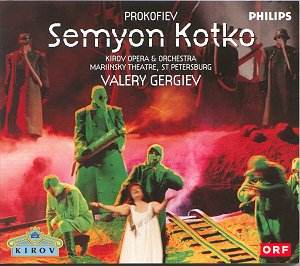Sergei PROKOFIEV (1891-1953)
Semyon Kotko - opera in 5 acts
(1938)
 Semyon Kotko - Viktor
Lutsiuk
Semyon Kotko - Viktor
Lutsiuk
Semyon's mother - Lyudmila Filatova
Frosya, Semyon's sister - Olga Savova
[and many others]
Kirov Chorus and Orchestra/Valery Gergiev
Maryinsky Theatre, St Petersburg
rec live by Austrian Radio, Vienna, 19-21 Nov
1999
 PHILIPS 464 605-2 [58.15]
[78.31] 2CDs
[136.46]
PHILIPS 464 605-2 [58.15]
[78.31] 2CDs
[136.46]
Crotchet
Amazon
UK Amazon USA

Kotko is set in the Ukraine during the Great War. Its plot-line weaves the
duplicity of the aristocracy, with the struggle against the German insurgents
and the heroism of the proletariat. A few bloody corners have been knocked
off history in the retelling but this need not dismay us. After all we have
forgiven Hollywood often enough for the same thing. Poetic licence runs a
long way.
The lucid notes (by Andrew Huth) point up the role the opera was intended
to serve. Kotko was to tap into Soviet realism. It was not to be a typically
fragmentary 'daisy chain' of arias and dances. Instead it is an accessible
drama proceeding filmicly with plenty of action and engagement with the audience.
Its lyrical accessibility can be representatively judged by sampling the
orchestral introduction right at the start of the opera and in Act 3 scene
1. In the first there is the rolling legato sea-swell of the strings. In
the latter a theme, suave and honeyed, laced with a presentiment of tragedy.
This winds with easy beauty through the action. That great theme is clearly
related to the romance of Prokofiev's Romeo and Juliet.
The Neapolitan serenading of scene 5 act 3 'Rano rano ranenko' takes us into
Tchaikovsky territory (Eugene Onegin), the Rachmaninov songs and the feminine
softness of Prokofiev's own Onegin music. This is a very emotional opera
- just listen also to the restraint and sincerity of Kotko's 'ma ma' at track
2.38.
The plot moves along economically if not always very convincingly. The music
follows the same line. Ideas flow along quickly. There is little repetition.
The music is accessible without being crass. Thank heavens this is no folk
opera. There are aspects of Vaughan Williams' village opera Hugh the Drover,
for example, with its rum-ti-tum' jollity, that leave me cold (contrasted
with Sir John in Love and Pilgrim's Progress). Prokofiev largely avoids these
traps.
The cinematographic parallel made by the note writer is a good one and evident
from the structure. Each of the five acts is divided into tableaux and each
of these further comprise scenes. The scenes fly by each between 1'30" and
5'. Each is tracked separately. Scenes move onwards without studied pauses
- another filmic touch. Each tableau is presented as a continuum.
Prokofiev's 'jaggedness' is little in evidence though track 15 CD2 is not
free from this. While his angularity laces the lyricism with pepper and salt
it is the lyrical side that dominates. Prokofiev's Troika jollity (a Kije
'trademark') is on show at the end of act 4 (CD2 track 23) as Semyon and
comrades gallop off to harry the Germans with machine guns and grenades.
The singing is excellent. If you would like to sample the rousing strengths
and nobility of the male singers try track 17 CD2 - Remeniuk's Tak ... Tak
song. For me the only staggering misfire is the final musically hollow paean
to the struggle of the Russian people and the freedom of the Ukraine.
Philips have shown enviable firmness of commitment in working with the Kirov.
Over the last ten years (is it more?) they have issued production after
production and are now delving deeper into the darker corners of Russian
opera. They have already issued Prokofiev's operas: The Gambler 454 559;
Betrothal in a Monastery 462 107; The Fiery Angel 446 078 and War and Peace
434 097.
The dumpy booklet, on rice paper, runs to 300 pages. The text is English,
French and German while the libretto is in four columns: transliterated sung
Russian text alongside the trilingual translation. Philips list the scenes
and link them to track numbers, track timings and relevant page in the libretto.
I also noted the absence of profiles of the artists. This is unusual and
I praise Philips for their 'contra torrentum' decision. It speaks volumes
of their priority directed to the music and away from A&R personality
promotion. Less praiseworthy is the packaging which uses a slip case, several
thicknesses of card as a spacer and a double width box instead of the singled
width double CD jewel cases now available. Wasteful of space and materials.
Ever heard of Agenda 21 and Rio?
It would be good to delve further into this era with recordings of Ivan
Dzerzhinsky's two, broadly contemporaneous, Sholokhov operas (And Quiet Flows
the Don was phenomenally successful during the late thirties in the USSR)
and further afield with the late Inglis Gundry's opera The Partisans.
I warmly recommend this opera to anyone who has already leapt from Rachmaninov
or Tchaikovsky to Prokofiev's Romeo and War and Peace and likes what they
hear. Semyon will repay your time with concisely articulated grand opera,
If its political motivation is now unfashionable or objectionable do not
let that stand in the way of some gratifying and occasionally stunning music.
Reviewer
Rob Barnett

